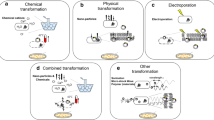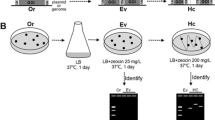Summary.
Two entry exclusion genes (designatedeexA andeexB) from the promiscuous IncPα plasmid R18 have been isolated by molecular cloning. They are located between coordinates 26.6–27.4 kb and 27.4–27.6 kb, respectively and are transcribed clockwise on the conventional R18 map. The product of theeexA gene has an apparent molecular mass of 28 kDa and its N-terminus contains a putative signal sequence for protein export. A recombinant plasmid containing R18eex genes exerted Eex activity towards another promiscuous IncPα plasmid, R702, about 50 times more strongly than plasmid R18 itself. Analysis of the DNA sequence revealed no similarity to the eex genes of the F plasmid ofEscherichia coli. R18eexA includes a potentialkorB binding site and is followed by a potential transcription terminator. A Tn7 insertion at coordinate 20.0 kb of R18 resulted in a host range mutant pM01185, which leads to loss of Eex activity and of conjugative transfer of the plasmid into some bacterial species.
Similar content being viewed by others
References
Achtman M, Kennedy N, Skurray R (1977) Cell-cell interactions in conjugatingEscherichia coli: Role oftraT protein in surface exclusion. Proc Natl Acad Sci USA 74:5104–5108
Achtman M, Manning PA, Kusecek B, Schwuchow S, Willetts N (1980) A genetic analysis of F sex factor cistrons needed for surface exclusion inEscherichia coli. J Mol Biol 138:779–795
Agüero ME, Aron L, DeLuca AG, Timmis KN, Cabello FC (1984) A plasmid encoded outer membrane protein, TraT, enhances resistance ofEscherichia coli to phagocytosis. Infect Immun 46:740–746
Bachmann BJ (1972) Pedigrees of some mutant strains ofEscherichia coli K12. Bacteriol Rev 36:525–557
Bachmann BJ (1990) Linkage map ofEscherichia coli K12, Edition 8. Microbiol Rev 54:130–197
Barth PT (1979) RP4 and R300B as wide host-range plasmid cloning vehicles. In: Timmis KN, Pühler A (eds) Plasmids of medical, environmental and commercial importance. Elsevier/North Holland Biomedical Press, Amsterdam, pp 399–410
Bibb MJ, Findlay PR, Johnson MW (1984) The relationship between base composition and codon usage in bacterial genes and its use for the simple and reliable identification of protein coding sequences. Gene 30:157–166
Biggin MD, Gibson TJ, Hong GF (1983) Buffer gradient gels and35S label as an aid to rapid DNA sequence determination. Proc Natl Acad Sci USA 80:3963–3965
Brendel V, Trifonov EN (1984) A computer algorithm for testing potential procaryotic terminators. Nucleic Acids Res 12:4411–4427
Burkardt HJ, Riess G, Pnhler A (1979) Relationship of group P1 plasmids revealed by heteroduplex experiments: RP1, RP4, R68 and RK2 are identical. J Gen Microbiol 114:341–348
Burkardt HJ, Pühler A, Wohlleben W (1980) Adenine+thymine content of different genes located on the broad host range plasmid RP4. J Gen Microbiol 117:135–140
Chikami GK, Guiney DG, Schmidhauser TJ, Helinski DR (1985) Comparison of 10 IncP plasmids: Homology in the regions involved in plasmid replication. J Bacteriol 162:656–660
Covarrubias L, Bolivar F (1982) Construction and characterization of new cloning vehicles. VI. Plasmid pBR329 a new derivative of pBR328 lacking the 482 base pair inverted duplication. Gene 17:79–89
Cowan P, Krishnapillai V (1982) Tn7 insertion mutations affecting the host range of the promiscuous IncP-1 plasmid R18. Plasmid 8:164–174
Devereux J, Haeberli P, Smithies O (1984) A comprehensive set of sequence analysis programs for the VAX. Nucleic Acids Res 12:387–395
Fietta A, Romero E, Siccardi AG (1977) Effect of some R factors on the sensitivity of rough enterobacteriaceae to human serum. Infect Immun 18:278–282
Finlay BB, Paranchych W (1986) Nucleotide sequence of the surface exclusion genestraS andtraT from the IncF0lac plasmid pED208. J Bacteriol 166:713–721
Freier MS, Kierzek R, Jaeger JA, Sugimoto N, Caruthers MH, Neilson T, Turner DH (1986) Improved free energy parameters for predictions of RNA duplex stability. Proc Natl Acad Sci USA 83:9373–9377
Fürste JP, Pansegrau W, Franck R, Blöcker H, Scholz P, Bagdasarian M, Lanka E (1986) Molecular cloning of the RP4 DNA primase region in a multi-host-rangetacP expression vector. Gene 48:119–131
Gribskov H, Devereux J, Burgess RR (1984) The codon preference plot: Graphic analysis of protein coding sequences and prediction of gene expression. Nucleic Acids Res 12:539–549
Guiney DG, Lanka E (1989) Conjugative transfer of IncP plasmids. In: Thomas CM (ed) Promiscuous plasmids of Gram-negative bacteria. Academic Press, London, pp 27–54
Ham LM, Cram D, Skurray R (1989) Transcriptional analysis of the F plasmid surface exclusion region: Mapping oftraS, traT, andtraD transcripts. Plasmid 21:1–8
Harley CB, Reynolds RP (1987) Analysis ofE. coli promoter sequences. Nucleic Acids Res 15:2343–2361
Hauer B, Shapiro JA (1984) Control of Tn7 transposition. Mol Gen Genet 194:149–158
Hedges RW, Cresswell JM, Jacob E (1976) A nontransmissible variant of RP4 suitable as cloning vehicle for genetic engineering. FEBS Lett 61:186–188
Jalajakumari MB, Guildon A, Bukh HJ, Manning PA, Ham LM, Hodgson ALM, Cheah KC, Skurray RA (1987) Surface exclusion genestraS andtraT of the F sex factor ofEscherichia coli K12. J Mol Biol 198:1–11
Kornacki JA, Burlage RS, Figurski DH (1990) Thekil-kor regulon of broad-host-range plasmid RK2: Nucleotide sequence, polypeptide product, and expression of regulatory genekorC. J Bacteriol 172:3040–3050
Krishnapillai V, Nash J, Lanka E (1984) Insertion mutations in the promiscuous IncP-1 plasmid R18 which affect its host range between Pseudomonas species. Plasmid 12:170–180
Lanka E, Lurz R, Fürste JP (1983) Molecular cloning and mapping ofSphI restriction fragments of plasmid PR4. Plasmid 10:303–307
Manning PA, Achtman M (1979) Cell to cell interactions in conjugatingEscherichia coli: The involvement of the cell envelope. In: Inouye M (ed) Bacterial outer membranes: Biogenesis and functions. J Wiley and Sons, New York, pp 409–447
Messing J, Crea R, Seeburg PH (1981) A system for shotgun DNA sequencing. Nucleic Acids Res 9:309–321
Minkley EG (1984) Purification and characterization of pro-TraTp, the signal sequence containing precursor of a secreted protein encoded by the F sex factor. J Bacteriol 158:464–473
Minkley EG, Ippen-Ihler K (1977) Identification of a membrane protein associated with expression of the surface exclusion region of the F transfer operon. J Bacteriol 129:1613–1622
Minkley EG, Willetts NS (1984) Overproduction, purification and characterization of the FtraT protein. Mol Gen Genet 196:225–235
Moll A, Manning PA, Timmis KN (1980) Plasmid determined resistance to serum bactericidal activity: A major outer membrane protein, thetraT gene product is responsible for plasmid specified serum resistance inEscherichia coli. Infect Immun 28:359–367
Novick RP, Clowes RC, Cohen SN, Curtiss R, Datta N, Falkow S (1976) Uniform nomenclature for bacterial plasmids: A proposal. Bacteriol Rev 40:168–189
Ogata RT, Winters C, Levine RP (1982) Nucleotide sequence analysis of the complement resistance gene from plasmid R100. J Bacteriol 151:819–827
Palombo EA, Yusoff K, Stanisich VA, Krishnapillai V, Willetts NS (1989) Cloning and genetic analysis oftra cistrons of the Tra2/Tra3 region of plasmid RP1. Plasmid 22:59–69
Perumal BN, Minkley EG (1984) The product of the F sex factortraT surface exclusion gene is a lipoprotein. J Biol Chem 259:5357–5360
Riede J, Eschbach ML (1986) Evidence that TraT interacts with OmpA ofEscherichia coli. FEBS Lett 205:241–245
Sambrook J, Fritsch EF, Maniatis T (1989) Molecular cloning: a laboratory manual. Cold Spring Harbor Laboratory Press, Cold Spring Harbor, New York
Sanger F, Coulson AR (1978) The use of thin acrylamide gels for DNA sequencing. FEBS Lett 87:107–110
Sanger F, Nicklen S, Coulson AR (1977) DNA sequencing with chain-terminating inhibitors. Proc Natl Acad Sci USA 74:5463–5467
Stokes HW, Moore RJ, Krishnapillai V (1981) Complementation analysis inPseudomonas aeruginosa of the wide host range R plasmid R18. Plasmid 5:202–212
Thomas CM, Helinski DR (1989) Vegetative replication and stable inheritance of IncP plasmids. In: Thomas CM (ed) Promiscuous plasmids of Gram-negative bacteria. Academic Press, London, pp 1–25
Thomas CM, Smith CA (1987) Incompatibility group P plasmids: Genetics, evolution and use in genetic manipulation. Annu Rev Microbiol 41:77–101
Watson MEE (1984) Compilation of published signal sequences. Nucleic Acids Res 12:5145–5164
Yanisch-Perron C, Vieira J, Messing J (1985) Improved M13 phage cloning vectors and host strains: Nucleotide sequences of the M13mp18 and pUC19 vectors. Gene 33:103–119
Ziegelin G, Pansegrau W, Strack B, Balzer D, Kröger M, Kruft V. Lanka E (1991) Nucleotide sequence and organization of genes flanking the transfer origin of promiscuous plasmid RP4.
Author information
Authors and Affiliations
Additional information
Communicated by W. Goebel
Rights and permissions
About this article
Cite this article
Lessl, M., Krishnapillai, V. & Schilf, W. Identification and characterization of two entry exclusion genes of the promiscuous IncP plasmid R18. Molec. Gen. Genet. 227, 120–126 (1991). https://doi.org/10.1007/BF00260716
Received:
Issue Date:
DOI: https://doi.org/10.1007/BF00260716




